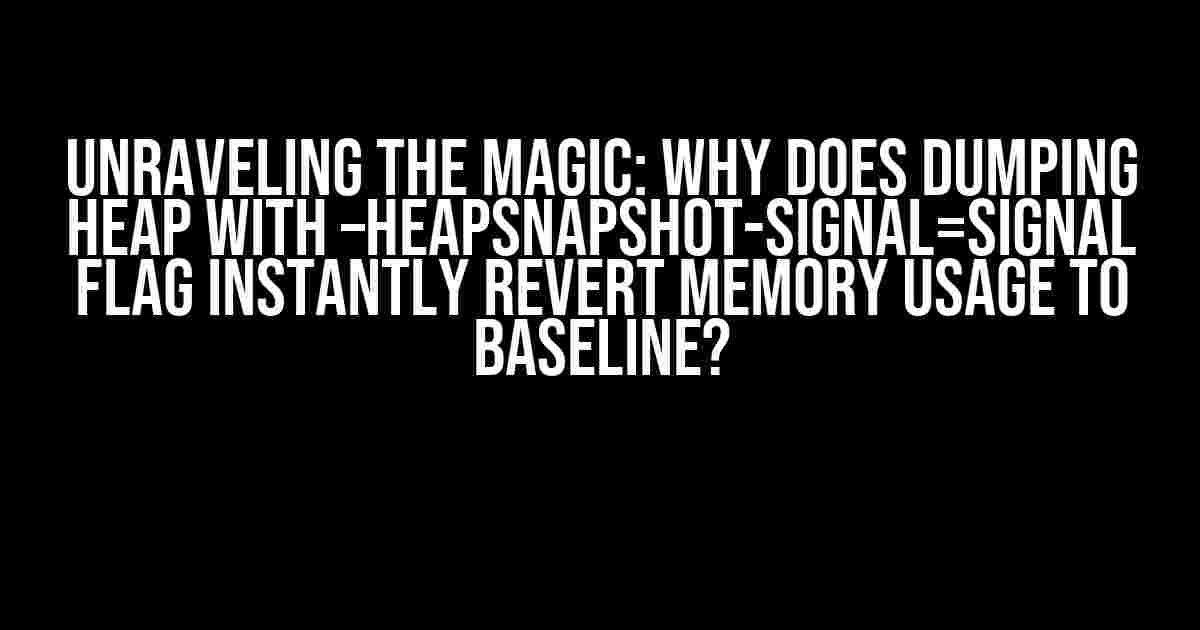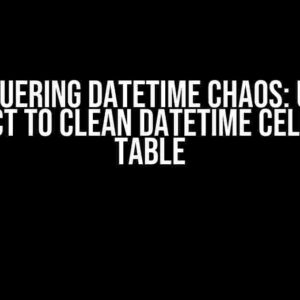As developers, we’ve all been there – staring at our application’s memory usage graphs, wondering why they’re skyrocketing like a SpaceX rocket. You’ve tried everything: optimizing code, garbage collecting, and even performing voodoo rituals, but nothing seems to work. That is, until you stumbled upon the mystical --heapsnapshot-signal=signal flag. But what sorcery is this, and how does it instantly revert memory usage to baseline?
The Mysterious Case of the Leaking Memory
The Culprits: Retained Objects and Circular References
So, what’s causing this memory mayhem? More often than not, it’s retained objects and circular references. These sneaky culprits keep your objects alive, even when they’re no longer needed. It’s like they’re saying, “Hey, I know you think you’re done with me, but I’m still useful, I swear!”
// Example of a retained object
let myObject = { foo: 'bar' };
myObject.selfReference = myObject;
// Example of a circular reference
let obj1 = { foo: 'bar' };
let obj2 = { baz: obj1 };
obj1.qux = obj2;
In these examples, myObject and obj1 are retained, preventing the garbage collector from freeing up the memory.
Enter the Hero: –heapsnapshot-signal=signal Flag
Now that we’ve identified the culprits, it’s time to bring in the cavalry. The --heapsnapshot-signal=signal flag is a powerful tool that helps you debug and fix memory-related issues. It works by creating a heap snapshot when a signal is received, allowing you to analyze the memory usage and identify the root cause of the problem.
How to Use the –heapsnapshot-signal=signal Flag
To use the flag, simply add it to your Node.js command:
node --heapsnapshot-signal=signal your-application.jsOnce you’ve added the flag, you can send a signal to your application using a tool like kill (on Linux/macOS) or taskkill (on Windows). The signal will trigger the heap snapshot, which will be saved to a file.
# On Linux/macOS
kill -USR2
# On Windows
taskkill /pid /signal USR2 Replace
Analyzing the Heap Snapshot
Now that you’ve generated the heap snapshot, it’s time to analyze it. You can use the Chrome DevTools to load the snapshot and start digging into the memory usage.
Identifying Retained Objects and Circular References
In the DevTools, you can use the “Retainers” view to identify the objects that are preventing garbage collection. This will help you pinpoint the culprits responsible for the memory leak.
| 1 | Open the Chrome DevTools and select the “Memory” tab. |
| 2 | Load the heap snapshot by clicking on the “Load heap snapshot” button. |
| 3 | Select the “Retainers” view. |
| 4 | Expand the nodes to explore the retained objects and circular references. |
By following these steps, you’ll be able to identify the objects that are causing the memory leak and take corrective action to fix the issue.
The Instant Fix: Why the –heapsnapshot-signal=signal Flag Works Magic
So, why does dumping the heap with the --heapsnapshot-signal=signal flag instantly revert memory usage to baseline? The answer lies in how the flag works.
The Magic Happens: V8’s Garbage Collection and heapDumpOnSignal
When you add the --heapsnapshot-signal=signal flag, V8 (Node.js’s JavaScript engine) enables the heapDumpOnSignal feature. This feature allows V8 to generate a heap snapshot when a signal is received.
Here’s what happens behind the scenes:
- The signal is received, triggering the heap snapshot.
- V8 performs a full garbage collection, which frees up any unreachable objects.
- The heap snapshot is generated, capturing the current state of the heap.
By performing a full garbage collection, V8 ensures that any retained objects and circular references are cleared, effectively reverting memory usage to baseline.
Conclusion: The Power of –heapsnapshot-signal=signal
The --heapsnapshot-signal=signal flag is a powerful tool in your debugging arsenal. By using it to generate heap snapshots and analyze memory usage, you can identify and fix memory-related issues in your Node.js application. Remember, the key to resolving memory leaks lies in understanding how V8’s garbage collection works and leveraging the heapDumpOnSignal feature to your advantage.
So, the next time you’re faced with a memory leak, don’t panic. Just grab your trusty --heapsnapshot-signal=signal flag, and get ready to uncover the secrets of your application’s memory usage.
Happy debugging!
Frequently Asked Question
Get the inside scoop on dumping heap with the –heapsnapshot-signal=signal flag and how it instantly reverts memory usage to baseline.
What is the purpose of the –heapsnapshot-signal=signal flag?
The –heapsnapshot-signal=signal flag is used to generate a heap snapshot when the specified signal is received. This flag allows you to capture the heap state at a specific point in time, making it easier to analyze memory usage and detect issues.
How does the –heapsnapshot-signal=signal flag affect memory usage?
When the –heapsnapshot-signal=signal flag is used, the heap snapshot is generated immediately, and the memory usage reverts to the baseline level. This is because the flag triggers the garbage collector to clean up the heap, releasing any unnecessary memory and returning it to the system.
Why does the memory usage revert to the baseline level?
The memory usage reverts to the baseline level because the heap snapshot is generated based on the current heap state. When the snapshot is taken, the garbage collector removes any unreachable objects, freeing up memory and bringing the usage back down to the baseline level.
Can I customize the behavior of the –heapsnapshot-signal=signal flag?
Yes, you can customize the behavior of the –heapsnapshot-signal=signal flag by combining it with other flags or options. For example, you can use the –heapsnapshot-on-fatal-exception flag to generate a heap snapshot when the application crashes, or the –heapsnapshot-on-oom flag to generate a snapshot when the application runs out of memory.
Are there any performance implications of using the –heapsnapshot-signal=signal flag?
Yes, using the –heapsnapshot-signal=signal flag can have performance implications, especially if used frequently. Generating a heap snapshot can be a resource-intensive operation, and may cause temporary pauses in the application. However, the impact is typically minimal, and the benefits of identifying memory issues outweigh the costs.



